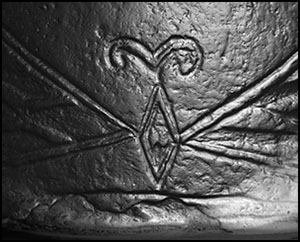Crossref Citations
This article has been cited by the following publications. This list is generated based on data provided by
Crossref.
Milner, Nicky
Bamforth, Michael
Beale, Gareth
Carty, Julian C.
Chatzipanagis, Konstantinos
Croft, Shannon
Conneller, Chantal
Elliott, Ben
Fitton, Laura C.
Knight, Becky
Kroger, Roland
Little, Aimée
Needham, Andy
Robson, Harry K.
Rowley, Charlotte C.A.
and
Taylor, Barry
2016.
A Unique Engraved Shale Pendant from the Site of Star Carr: the oldest Mesolithic art in Britain.
Internet Archaeology,
Jones, Andrew Meirion
Díaz-Guardamino, Marta
Gibson, Alex
and
Cox, Sylvia
2017.
The Garboldisham Macehead: its Manufacture, Date, Archaeological Context and Significance.
Proceedings of the Prehistoric Society,
Vol. 83,
Issue. ,
p.
383.
Jones, Andy M.
and
Goskar, Thomas
2017.
Hendraburnick ‘Quoit’: recording and dating rock art in the west of Britain.
Time and Mind,
Vol. 10,
Issue. 3,
p.
277.
Kotoula, E.
Robinson, D.W.
and
Bedford, C.
2018.
Interactive relighting, digital image enhancement and inclusive diagrammatic representations for the analysis of rock art superimposition: The main Pleito cave (CA, USA).
Journal of Archaeological Science,
Vol. 93,
Issue. ,
p.
26.
Horn, Christian
and
Potter, Rich
2018.
Transforming the Rocks – Time and Rock Art in Bohuslän, Sweden.
European Journal of Archaeology,
Vol. 21,
Issue. 3,
p.
361.
Cerrillo-Cuenca, Enrique
Bueno-Ramírez, Primitiva
and
de Balbín-Behrmann, Rodrigo
2019.
“3DMeshTracings”: A protocol for the digital recording of prehistoric art. Its application at Almendres cromlech (Évora, Portugal).
Journal of Archaeological Science: Reports,
Vol. 25,
Issue. ,
p.
171.
Teather, Anne
Chamberlain, Andrew
and
Parker Pearson, Mike
2019.
The chalk drums from Folkton and Lavant: Measuring devices from the time of Stonehenge.
British Journal for the History of Mathematics,
Vol. 34,
Issue. 1,
p.
1.
Elliott, Ben
2019.
Craft Theory in Prehistory: Case Studies from the Mesolithic of Britain and Ireland.
Proceedings of the Prehistoric Society,
Vol. 85,
Issue. ,
p.
161.
Papadopoulos, Costas
Hamilakis, Yannis
Kyparissi-Apostolika, Nina
and
Díaz-Guardamino, Marta
2019.
Digital Sensoriality: The Neolithic Figurines from Koutroulou Magoula, Greece.
Cambridge Archaeological Journal,
Vol. 29,
Issue. 4,
p.
625.
Díaz-Guardamino, Marta
García-Sanjuán, Leonardo
Wheatley, David
Lozano-Rodríguez, José Antonio
Rogerio-Candelera, Miguel Ángel
and
Casado-Ariza, Manolo
2020.
Late Prehistoric Stelae, Persistent Places and Connected Worlds: A Multi-disciplinary Review of the Evidence at Almargen (Lands of Antequera, Spain).
Cambridge Archaeological Journal,
Vol. 30,
Issue. 1,
p.
69.
Greaves, Alan M.
Duffy, Sarah
Peterson, J. R.
Tekoğlu, Ş. Recai
and
Hirt, Alfred
2020.
Carved in Stone: Field Trials of Virtual Reflectance Transformation Imaging (V-RTI) in Classical Telmessos (Fethiye).
Journal of Field Archaeology,
Vol. 45,
Issue. 7,
p.
542.
Reilly, Paul
and
Dawson, Ian
2021.
Track and Trace, and Other Collaborative Art/Archaeology Bubbles in the Phygital Pandemic.
Open Archaeology,
Vol. 7,
Issue. 1,
p.
291.
Trimmis, Konstantinos P.
2021.
An elegy of stone and light: Applying digital imaging methods for the recording of the Aegean stone kernoi in the context of Akrotiri, Thera.
Journal of Archaeological Science: Reports,
Vol. 40,
Issue. ,
p.
103249.
Davis, Bob
Harding, Phil
and
Leivers, Matt
2021.
Reflectance Transformation Imaging (RTI) Investigation of Engraved Chalk Plaques from the Stonehenge Region.
Proceedings of the Prehistoric Society,
Vol. 87,
Issue. ,
p.
133.
Fowler, Chris
2021.
Ontology in Neolithic Britain and Ireland: Beyond Animism.
Religions,
Vol. 12,
Issue. 4,
p.
249.
Jones, Andrew Meirion
and
Díaz-Guardamino, Marta
2022.
Making a Mark: Process, Pattern and Change in the British and Irish Neolithic.
Cambridge Archaeological Journal,
Vol. 32,
Issue. 3,
p.
389.
Immonen, Visa
2022.
The Palgrave Handbook of Digital and Public Humanities.
p.
377.
Potter, Rich
Rönnlund, Robin
and
Wallensten, Jenny
2023.
An evaluation of Substance Painter and Mari as visualisation methods using the Piraeus Lion and its runic inscriptions as a case study.
Heritage Science,
Vol. 11,
Issue. 1,
Frieman, Catherine J.
2023.
Archaeology as History.
Rodríguez-Corral, Javier
and
Rodríguez-Rellán, Carlos
2023.
In the land of tin men? Warrior stelae, mobility, and interaction in western Iberia during the Late Prehistory.
Archaeological and Anthropological Sciences,
Vol. 15,
Issue. 11,
